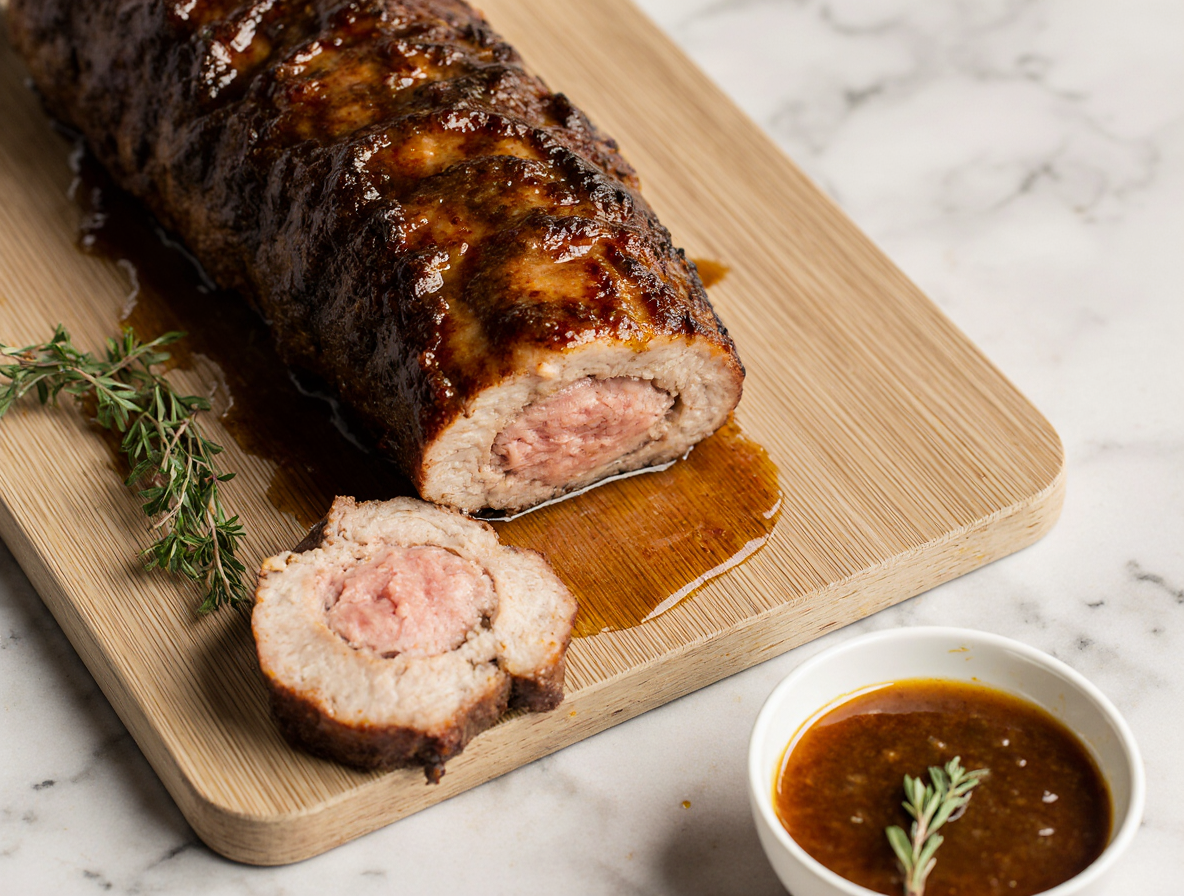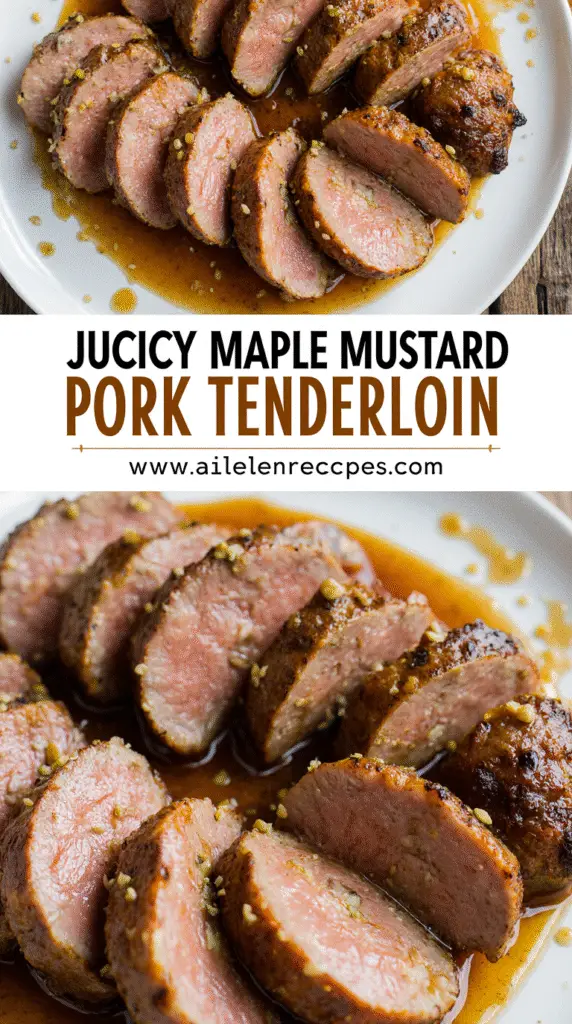How to Make Perfect Maple Mustard Pork Tenderloin in Just 30 Minutes
Did you know that mustard maple pork tenderloin can be ready in as little as 30 minutes?
Pork tenderloin is one of my favorite cuts of meat for quick weeknight dinners. Not only does it cook rapidly, but it’s also incredibly forgiving and usually inexpensive. Additionally, when properly prepared, this cut becomes as tender as steak after a quick sear in the skillet.
The USDA recommends cooking whole cuts of pork to an internal temperature of 145 degrees followed by a resting period. This ensures your maple glazed pork tenderloin remains juicy and flavorful rather than dry and tough. In fact, at just 288 calories per serving with 24g of protein, this maple dijon pork tenderloin isn’t just delicious—it’s nutritious too.
For the perfect maple syrup pork tenderloin, there’s one essential tool you’ll need: a very accurate thermometer. This simple device makes all the difference between perfectly cooked pork tenderloin maple mustard and a disappointing dinner.
In this article, we’ll walk through creating a saucy, succulent, and tender maple mustard pork tenderloin that pairs beautifully with sides like mashed potatoes or garlic cheese toast. Let’s get cooking!
Trim, Season, and Prep the Pork
Before cooking the perfect maple mustard pork tenderloin, proper preparation is essential. The difference between mediocre and magnificent often lies in these initial steps.
Remove silver skin and excess fat
The first step in preparing your maple glazed pork tenderloin is removing the silver skin – that shiny, silvery-white membrane on one side of the tenderloin. This isn’t just for appearance; if left on, the silver skin becomes tough, chewy, and nearly inedible when cooked. Moreover, as the meat cooks and shrinks, the silver skin tightens, causing your tenderloin to twist and cook unevenly.
To remove it properly:
- Locate the silver skin (it appears as a different shade of pink than the rest of the meat)
- Slide a sharp, thin knife between the silver skin and meat
- Tilt the knife blade slightly upward while holding the skin with your other hand
- Cut slowly away from yourself until you reach the end of the silver skin
While you’re at it, trim any excess fat from the tenderloin. Unlike other cuts, pork tenderloin is naturally lean, making it a healthier option.
Pat dry for better browning
After trimming, I always pat the tenderloin thoroughly dry with paper towels. This seemingly simple step serves a crucial purpose – moisture is the enemy of proper browning. Consequently, removing surface moisture ensures your maple syrup pork tenderloin develops that gorgeous caramelized exterior during searing.
Apply dry rub or basic seasoning
For a simple yet flavorful maple dijon pork tenderloin, you have two excellent options:
First, a basic seasoning of salt and pepper works wonderfully (about 1 teaspoon salt and ½ teaspoon pepper per tenderloin). This allows the natural pork flavor to shine while complementing the maple mustard glaze we’ll apply later.
Alternatively, create a dry rub that enhances your pork tenderloin maple mustard glaze. In a bowl large enough to fit your tenderloin, combine brown sugar, smoked paprika, garlic powder, onion powder, salt, and your choice of herbs. Then toss the tenderloin in this mixture until completely coated.
Some recipes recommend piercing the meat all over with a fork before applying oil and seasonings. This helps the flavors penetrate deeper into the meat.
Finally, if time permits, let the seasoned tenderloin sit at room temperature for about 20 minutes. This takes the chill off and helps it cook more evenly.
Make the Maple Mustard Glaze
The maple mustard glaze is what truly elevates this dish from ordinary to extraordinary. This sweet-tangy sauce creates that perfect caramelized exterior while keeping your pork juicy and flavorful.
Combine Dijon, maple syrup, and vinegar
The foundation of any great maple mustard pork tenderloin begins with quality ingredients in the right proportions. In a small bowl, I start by combining:
- Dijon mustard – 2-4 tablespoons (you can substitute whole-grain mustard for added texture)
- Pure maple syrup – 2-4 tablespoons (always use real maple syrup, not pancake syrup)
- Vinegar – 1-2 tablespoons (apple cider vinegar works wonderfully)
Each component serves a specific purpose: the mustard provides tanginess and helps emulsify the glaze, the maple syrup rounds out sharp edges while adding natural sweetness and richness, and the vinegar brightens the entire mixture with necessary acidity.
Add garlic and herbs for depth
To create a more complex flavor profile for your maple glazed pork tenderloin, incorporating aromatic elements is essential:
First, add minced garlic – either one fresh clove or approximately ¼ teaspoon garlic powder. Fresh garlic provides more potent flavor, yet powder offers convenience and consistency.
Second, consider adding a pinch of dried herbs. Oregano or marjoram works beautifully with the maple-mustard combination. For those who enjoy a bit of umami depth, a splash of soy sauce (about 1 teaspoon) complements the sweetness perfectly.
Salt and pepper are crucial finishing touches – about ¼ teaspoon kosher salt and freshly ground black pepper to taste.
Whisk until smooth and set aside
Once all ingredients are in the bowl, whisk vigorously until completely combined. The mixture should have a smooth, slightly thick consistency – similar to heavy cream. For those who prefer a completely lump-free glaze, a small whisk works better than a fork.
Alternatively, place all ingredients in a mason jar with a tight-fitting lid and shake vigorously until well incorporated. This method is particularly effective for larger batches or if you’re making the glaze ahead of time.
Since our pork tenderloin maple mustard glaze contains vinegar, it can be prepared up to 3 days in advance and refrigerated in an airtight container. I always allow it to reach room temperature before using it on the maple dijon pork tenderloin for the best results.
Cook the Pork Tenderloin in the Oven
The cooking stage is where our maple glazed pork tenderloin transforms from raw to remarkable. This two-step cooking method ensures a perfectly caramelized exterior alongside a juicy interior.
Sear pork on all sides in a hot skillet
Heat 1-2 teaspoons of butter or oil in an oven-safe skillet (cast iron works best) over medium-high heat. Once hot, add your seasoned pork and sear for approximately 2-3 minutes per side. Rotate the tenderloin about ⅓ turn each time until all sides develop that beautiful golden-brown crust. Remember: color equals flavor!
Transfer to oven and roast at 400°F
Immediately move the skillet with your maple mustard pork tenderloin directly into a preheated 400°F oven. This dual cooking approach creates a delicious crust outside yet preserves juices inside.
Brush with glaze halfway through cooking
After about 7-8 minutes in the oven, quickly brush your maple dijon pork tenderloin with the prepared glaze. This timing allows flavors to penetrate without burning the sugars.
Use thermometer to check for 145°F internal temp
Roast until your maple syrup pork tenderloin reaches an internal temperature of 145°F. This typically takes 15-17 minutes total. Always check the thickest part with an instant-read thermometer. According to USDA guidelines, after reaching 145°F, let rest for at least 3 minutes. This ensures food safety plus optimal tenderness.
Rest, Slice, and Serve with Sauce
After your maple glazed pork tenderloin comes out of the oven, patience becomes your final secret ingredient. The finishing touches transform this dish from merely good to absolutely memorable.
Let pork rest for 5–10 minutes
Once your pork reaches that perfect 145°F internal temperature, resist the urge to slice immediately. Instead, allow it to rest for 5-10 minutes. This crucial step lets muscle fibers relax and reabsorb juices they’ve squeezed out during cooking. Without proper resting, those flavorful juices escape onto your cutting board instead of remaining in the meat. Although the USDA recommends a minimum 3-minute rest, extending to 10 minutes yields significantly better results, reducing juice loss from 8.6% to approximately 4%.
Slice into medallions
After resting, carve your maple mustard pork tenderloin into thin medallions. This presentation not only makes the pork easier to eat but also displays your culinary skills. For consistent thickness, use a sharp knife and cut perpendicular to the grain.
Drizzle with remaining glaze
Enhance your maple dijon pork tenderloin by drizzling the reserved maple-mustard mixture over your freshly sliced medallions. For an extra touch of richness, spoon some of the drippings from the bottom of your cooking vessel over the meat. This final application adds moisture and intensifies the sweet-tangy flavor profile.
Pair with mashed potatoes or greens
Your maple syrup pork tenderloin deserves worthy companions on the plate. Classic pairings include:
- Potatoes or rice to soak up the delicious sauce
- Simple salad for freshness
- Roasted vegetables for depth of flavor
Leftover pork makes excellent sandwiches—simply mix remaining sauce with mayonnaise for a spectacular sandwich spread.
Conclusion
This maple mustard pork tenderloin truly stands as one of the most rewarding yet simple dishes you can prepare at home. After mastering the techniques outlined above, you’ll find yourself returning to this recipe again and again. Most importantly, the combination of proper preparation, quality ingredients, and careful cooking transforms an ordinary cut of meat into something extraordinary.
The process starts with careful trimming and seasoning, continues through creating that perfect sweet-tangy glaze, and finishes with the crucial two-step cooking method. Throughout this journey, an accurate thermometer remains your most valuable tool, ensuring your tenderloin reaches that ideal 145°F internal temperature.
Let’s not forget the importance of patience during the final resting period. Those few extra minutes make all the difference between good and exceptional results. Subsequently, your beautifully sliced medallions drizzled with glaze will impress family and friends alike.
Finally, this versatile dish pairs wonderfully with countless sides – from classic mashed potatoes to fresh salads or roasted vegetables. Leftovers, if any remain, make fantastic sandwiches the next day. Therefore, next time you need a quick yet impressive meal, remember this maple mustard pork tenderloin recipe. It certainly delivers restaurant-quality results with minimal effort in your own kitchen.
FAQs
Q1. How long does it take to cook pork tenderloin? Pork tenderloin typically takes about 15-17 minutes to cook in a 400°F oven after searing. Always use a thermometer to check that the internal temperature reaches 145°F for food safety and optimal tenderness.
Q2. What ingredients are needed for a maple mustard glaze? A basic maple mustard glaze consists of Dijon mustard, pure maple syrup, and vinegar (preferably apple cider vinegar). For added depth, you can include minced garlic and herbs like oregano or marjoram.
Q3. Why is it important to let pork tenderloin rest after cooking? Resting pork tenderloin for 5-10 minutes after cooking allows the muscle fibers to relax and reabsorb juices, resulting in a more tender and flavorful meat. This step can reduce juice loss from 8.6% to approximately 4%.
Q4. Can mustard be used as a binder for pork tenderloin? Yes, mustard can be an excellent binder for pork tenderloin. It not only adds flavor but also helps other seasonings adhere to the meat and contributes to the formation of a flavorful crust during cooking.
Q5. What are some good side dishes to serve with maple mustard pork tenderloin? Maple mustard pork tenderloin pairs well with a variety of sides. Some popular options include mashed potatoes, rice, simple salads for freshness, or roasted vegetables for added depth of flavor. The side dishes can help soak up the delicious sauce and complement the sweet-tangy flavor of the pork.


